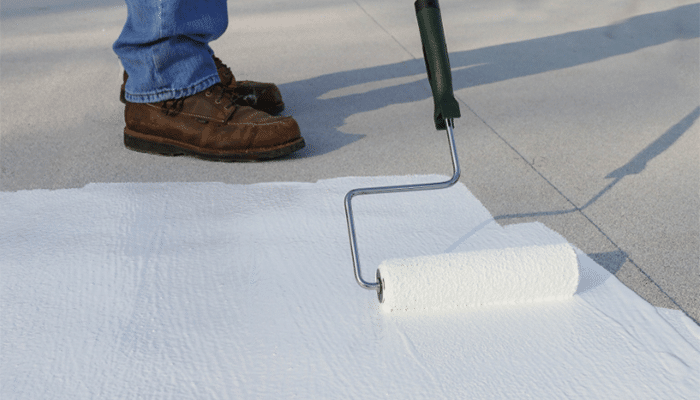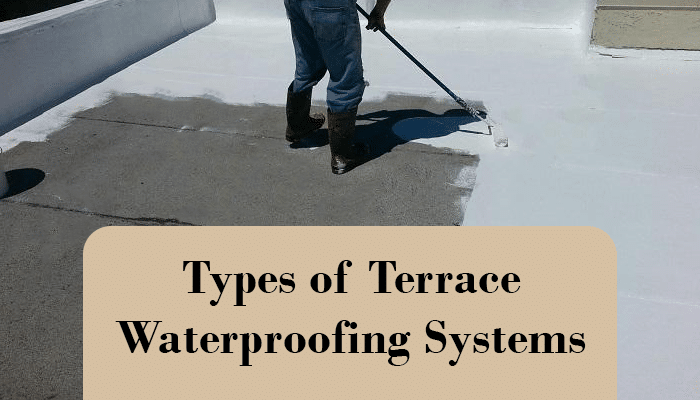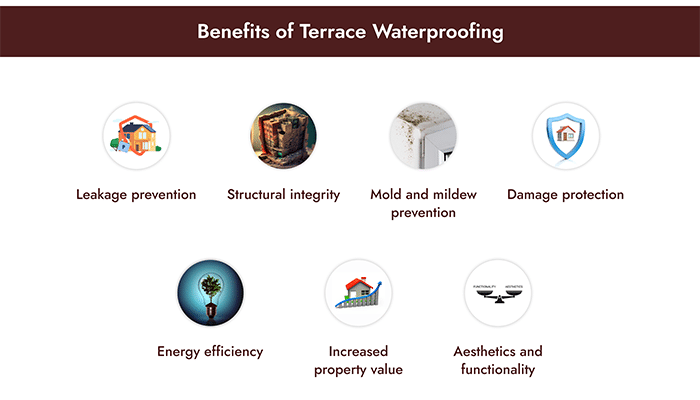Table of Contents
What is Terrace Waterproofing?

Waterproofing is an essential process that protects buildings and structures from the damaging effects of water penetration. Whether it’s a residential house, a commercial building, or an infrastructure project, waterproofing plays a crucial role in maintaining structural integrity, preventing moisture-related issues, and enhancing the longevity of the construction.
By understanding the waterproofing process, you will gain valuable insights into the importance of this construction technique and how it contributes to the durability and functionality of different structures.
Understanding the Waterproofing Process
Types of Terrace Waterproofing Systems

There are various types of terrace waterproofing systems available, each suited for different terraces and specific requirements. Some commonly used systems include:
| Terrace Waterproofing System | Characteristics |
| Cementitious Coating System | – Applied in multiple layers.- Provides excellent adhesion to concrete surfaces.- Forms a seamless and flexible barrier against water penetration.- Not resistant to UV- Requires surface preparation and skilled application. |
| Liquid Waterproofing Membrane | – Applied as a liquid coating.- Forms a continuous and seamless membrane.- Provides good flexibility and crack-bridging ability.- Can be applied on various surfaces such as concrete, metal, and wood.- Easy and quick application process.- Requires proper surface preparation. Waterproofing are of two types:Liquid waterproofing – It includes cementitious, acrylic, polyurea, polyurethaneMembrane waterproofing – It includes bitumen membrane, HDPE membrane, PVC membrane, TPO & EPDM membrane |
| Bituminous Membrane | – Made of bitumen and reinforced with polyester or fiberglass.- Offers good waterproofing and durability.- Can be applied as a torch-on or self-adhesive membrane.- Suitable for both new and existing terraces.- Not resistant to UV and temperature variations- Requires professional installation. |
| Polyurethane Coating System | – Provides excellent waterproofing and UV resistance.- Forms a seamless, elastic, and durable membrane.- Can be applied as a liquid coating or sprayed-on system.- Offers good crack-bridging properties.- Suitable for various substrates including concrete and metal.- Requires skilled application. |
| Acrylic Waterproofing System | – Water-based coating system.- Forms a breathable and flexible membrane.- Provides good UV resistance and color retention.- Easy application with brush, roller, or spray.- Can be applied on various surfaces including concrete and masonry.- Requires proper surface preparation and multiple coats. |
What are the Steps Involved in Terrace Waterproofing?
The terrace waterproofing process typically involves the following steps:
| Step 1 Surface Preparation: Clean the terrace thoroughly by removing any debris, dust, or loose materials. Ensure the surface is smooth and free from any cracks or irregularities. |
| Step 2 Repairing Cracks: Fill any existing cracks or gaps using a suitable crack filler or repair mortar. Make sure to address all the damaged areas to prevent water leakage in the future. |
| Step 3 Priming: Apply a waterproof primer on the entire surface to enhance adhesion and create a uniform substrate. This will improve the effectiveness of the waterproofing system. |
| Step 4 Reinforcement: Install a waterproofing reinforcement layer, such as a fiberglass mesh or polyester mat, to provide strength and prevent cracking in the waterproofing membrane. It may or may not be required, depending upon the selection of waterproofing product |
| Step 5 Waterproofing Application: Apply a liquid or sheet membrane over the entire terrace surface, including vertical surfaces and edges. Ensure proper overlap and coverage to create a continuous and watertight barrier. |
| Step 6: Sealing Joints: Seal all joints, including expansion joints and gaps around pipes or protrusions, using a suitable sealant. This will prevent water seepage through these vulnerable areas. |
| Step 7: Drainage System: Install an effective drainage system, including slope creation, drain pipes, and scuppers, to ensure proper water flow and prevent water accumulation on the terrace. |
| Step 8: Protective Coating: Apply a protective coating, such as an elastomeric or UV-resistant coating, over the waterproofing membrane to enhance durability and protect it from external elements. |
| Step 9: Curing and Drying: Allow the waterproofing system to cure and dry as per the manufacturer’s instructions. This typically involves a specific time period for the membrane and coating to achieve their optimal properties. |
| Step 10: Quality Check: Inspect the waterproofing system thoroughly to ensure there are no defects, gaps, or weak areas. Address any issues found during the inspection and make necessary repairs or adjustments. |
| Step 11 Finishing: Once the waterproofing is complete, the terrace can be finished with the desired flooring or decorative elements. Ensure the chosen materials are compatible with the waterproofing system. |
This is a general outline of the steps involved in terrace waterproofing, and specific requirements may vary depending on factors such as the type of terrace, climate conditions, and the waterproofing products used. It’s essential to follow the manufacturer’s instructions and consult with professionals for guidance in your specific situation.
Benefits of Terrace Waterproofing

Terrace waterproofing offers several benefits, especially in buildings and structures where terraces are exposed to the elements.
- Leakage prevention: The primary purpose of terrace waterproofing is to prevent water leakage. It creates a protective barrier that prevents water from seeping into the structure, thereby safeguarding the building from potential damage.
- Structural integrity: By preventing water infiltration, terrace waterproofing helps maintain the structural integrity of the building. Water seepage results into the corrosion of reinforcement in the concrete. Due to the corrosion, the steel expands and becomes weak. Due to this the concrete breaks and results in structural failure can weaken the foundation and concrete, leading to cracks, erosion, and deterioration of the building’s overall strength. Waterproofing safeguards against these issues, increasing the longevity of the structure.
- Mold and mildew prevention: Moisture and water ingress can create a favorable environment for mold and mildew growth. Terrace waterproofing prevents excessive moisture accumulation, reducing the risk of mold and mildew formation. This is crucial for the health of occupants as mold and mildew can cause respiratory problems and allergies.
- Damage protection: Terrace waterproofing acts as a shield against various forms of damage caused by water, such as corrosion, rusting, and degradation of materials. It prevents water from reaching reinforcement bars, electrical conduits, and other vulnerable components, thus reducing the chances of damage and subsequent repair costs.
- Energy efficiency: Terrace waterproofing can contribute to energy efficiency in buildings. It minimizes the transfer of heat and cold through the terrace, helping maintain a consistent indoor temperature. By reducing the need for excessive heating or cooling, it can lead to energy savings and lower utility bills.
- Increased property value: Waterproofing is considered a valuable investment in buildings. A well-maintained and waterproofed terrace enhances the overall value of the property. Potential buyers or tenants are likely to be more attracted to a property that has undergone proper waterproofing, knowing that it offers protection against water-related issues.
- Aesthetics and functionality: Waterproofing systems can be designed to enhance the aesthetic appeal of the terrace. There are various options available, including coatings, membranes, and finishes that can improve the visual appearance of the terrace while providing functionality. These coatings can also protect against UV radiation, which helps to prevent color fading and surface deterioration.
Conclusion
Proper protection and maintenance of your terrace are crucial, especially when it comes to combating the effects of harsh weather conditions like intense sunlight and heavy rainfall. That’s where terrace waterproofing plays a vital role. By ensuring effective waterproofing, you can prevent water from seeping through cracks in the walls and potentially causing the growth of mould and other issues. To achieve this, applying a waterproof coating proves to be highly advantageous.
Frequently Asked Questions (FAQs)
Why Is Terrace Waterproofing Necessary?
Terrace waterproofing or balcony waterproofing plays a crucial role in safeguarding your roof by acting as a protective membrane. This membrane serves as a reliable barrier against the damaging effects of external environmental factors and effectively prevents water leakage during heavy rainfall. By investing in terrace or balcony waterproofing, you not only enhance the longevity of your roof but also enjoy substantial savings in terms of repair and maintenance expenses. The waterproofing treatment acts as a proactive measure, mitigating wear and tear caused by weather fluctuations and ensuring the structural integrity of your roof remains intact.
How long does terrace waterproofing last?
The durability of terrace waterproofing can vary depending on several factors, such as the quality of materials used, the application method, environmental conditions, and maintenance practices. Generally, a well-executed and properly maintained terrace waterproofing system can last anywhere between 5 to 20 years. The type of waterproofing system chosen also plays a role in determining its lifespan. There are various methods available, including bituminous coatings, liquid-applied membranes, cementitious coatings, and polyurethane-based systems. Each of these options has different characteristics and durability.
Regular maintenance and timely repairs are essential for prolonging the lifespan of a terrace waterproofing system. Inspecting the terrace periodically for any signs of damage, such as cracks or leaks, and addressing them promptly can help prevent major issues and extend the effectiveness of the waterproofing. The lifespan mentioned above is a general estimate and can vary depending on the specific circumstances. Consulting with a professional waterproofing company like AapkaPainter can provide more accurate information based on your particular situation.
